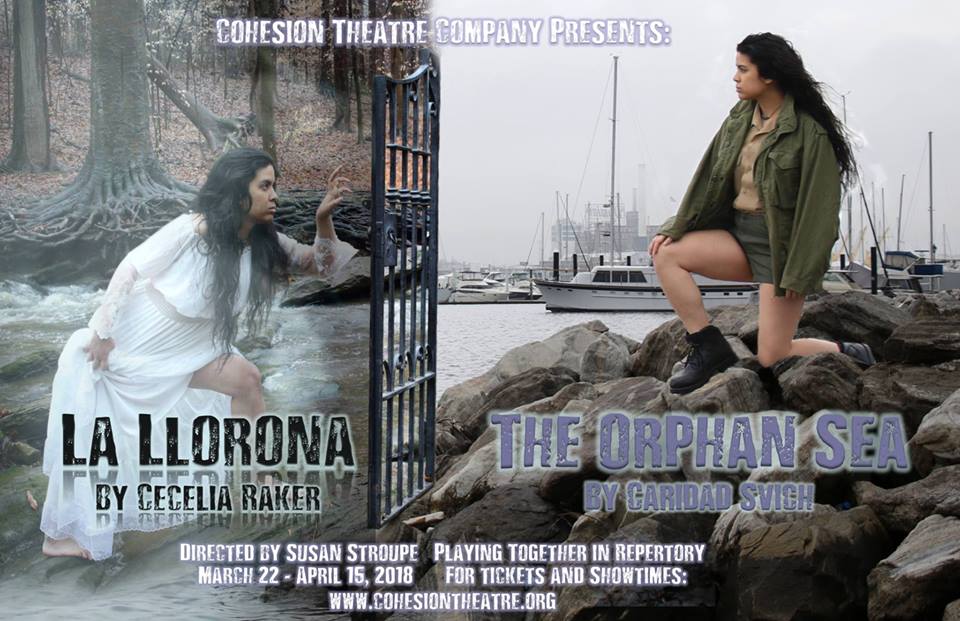Tell us your story. Let us talk with each other. But we will soon forget; that is the way of all things. Or is it? Will you forget their story? Partnered in repertory with La Llorona, in Cohesion Theatre Company’s first ever attempt at rotating repertory shows, The Orphan Sea by Caridad Svich boggles the mind over storytelling at its most primitive. Originally commissioned by The University of Missouri-Columbia Department of Theatre, this devised work now settles itself into the extraordinarily visionary hands of Director Susan Stroupe and her company of nine actors. Deconstructing the notion of mythology by reconstructing a semi-percolated, fully-inarticulated, script, Stroupe and the performance team accomplish herculean efforts with their avant garde, interpretation of this piece, which in itself is a devised work of their own.
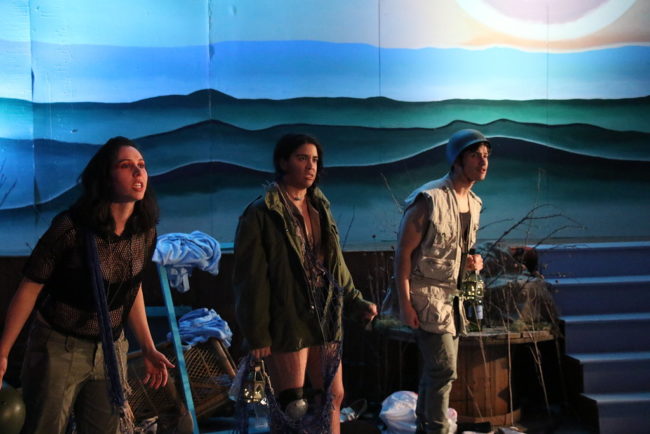
It is complex, to say the least, to describe what is happening on the stage; it is nothing short of a theatrical experience that combines ancient mythology with theatrical practice. Svich’s script is little more than a gathering of words on page and a collection of voices— no line assignments, no particular story arc— and Stroupe and the performers somehow manage an unfathomably impressive production with what little Svich gives them. Stroupe maintains a vision— an overarching starting and ending point that are tied together with the strikingly present presence of this gathering of nine— and keeps the audience invested in this ever-changing, hypnotically disorienting reality that is The Orphan Sea.
Once again Scenic Designer Jess Rassp is at the helm, inviting the audience into the visual depths of the show’s setting. Working in tandem with Lighting Designer Helen Garcia-Alton and Sound Designer Meghan Stanton, this trio of designers creates moments of ethereal reality amid epic mythology. Garcia-Altona and Stanton in particular fabricate striking combinations of sound and light that augment critical moments throughout the performance, many of which feel surreal but in a vivid and visceral dreamlike fashion. Rassp’s Greek mythological conceptualization is most prominently explored in her glorious painting of the floor.
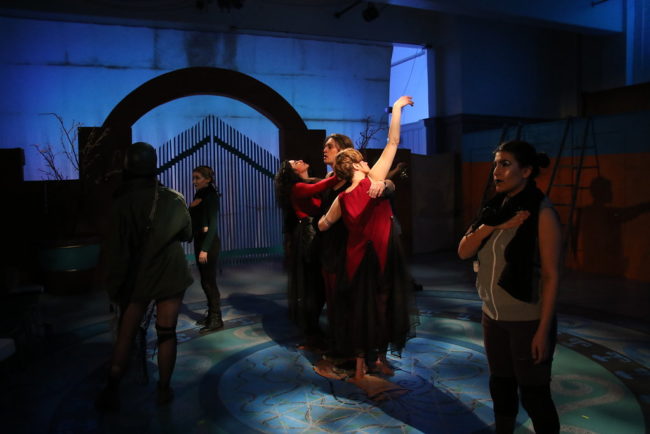
Director Susan Stroupe finds a grounding commonality in the production through her use of movement and pose. A great deal of the show’s movement actually occurs in stillness, in poses stricken, and in formations held. Such poses often resemble statuary— particularly in the Penelope Chorus and City Chorus (whom are often blending into the background as if they were the pillars of the city themselves)— and further entreat the audience to this idea of Greek mythology. Capturing the essence of these locations— the garden of Penelope, the war-torn sea of Odysseus— Stroupe manages to manifest an atmosphere through actor physicality, blocking, and movement.
Creating a gender fluidity among the cast, Stroupe cross-casts roles that are traditionally played by men and women, allowing these performers to explore “gendergies” (or the energy of gender) over the course of the performance. Men play women, women play men, women play a collective mass of men and women; the process is exhilarating and intriguing to say the least. Costume Designer Elizabeth Ung divides the three distinctive groups of Choruses— Penelope, Odysseus, and City— not on the gender line but rather into colored coordination that befits the characterization. All of the Penelopes wear flowing red and black; every Odysseus wears fatigues of some sort with camo beige and green coming into play. Ung reserves the most mythical and entrancing color of blue (enhanced with glitter and sparkles in the makeup department while other characters are enhanced with silver or gold) for the City Chorus. They are the narrators, the everyman, the Gods, and all voices at once, so they are the color of water and sky, of life itself.
Watching these nine performers play across this devised work is indeed a workout for the mind, but it’s an extraordinarily engaging one— the kind that feels satiatingly exhausting by the conclusion of the show. There is some thought required on the audiences’ end, but the actors carry a great deal of what’s being portrayed and parlayed in their various facial expressions, vocal inflections, and of course the aforementioned physicality that is so prevalent in this performance. Despite being gathered into their three groups, these individuals create unique moments on their own, inside of their choruses, and with other members of different choruses.
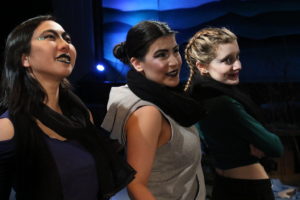
The City Chorus: Mika J. Nakano, Emily Sucher, and Mia Ybarra, are the best example of speaking in unison and with one voice. Although at times these three individuals speak one at a time, their voice is mystifying in the way that it carries from one person to the next, not dissimilar to the way the oracles of the past all shared a singular eyeball for seeing visions. Nakano, Sucher, and Ybarra become so much more than just the voices of the city. The are the rain, making droplet sounds and appropriate movement, the are the spirits, again with sounds and motions similar to that type of entity. They are ever-present, even when they are still, and this is perhaps the most fascinating facet of their performance. Watch them carefully during the “Life Lessons” segment; it’s disturbingly hypnotic.
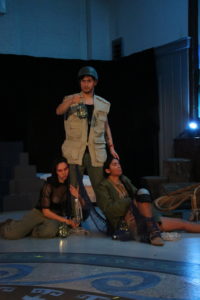
The Odysseus Chorus: Chara Bauer, Christian Gonzalez, and Mani Yangilmau, comprise the legendary man lost at sea. Constantly churning over the word hope, the way a tumultuous and tempestuous ocean washes over and over a single, solitary seashell, the way the storm their way through this production is quite thrilling and often puts the audience on the edge of their seat. When they are tossed and turned against the waves (moved and thrusted about with a sheet controlled by members of The City Chorus), it is spine-tingling to behold their struggle. While they are each an individual Odysseus, there are a great many composite scenes that feel as if they are led by Gonzalez’ Odysseus. Watching the way Gonzalez’ Odysseus meets his Penelope (Laura Malkus) is deliciously disturbing, sending shivers of multiple varieties up and down the spine.
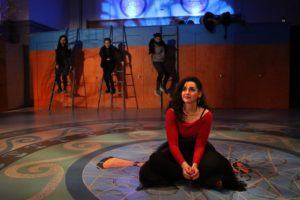
The Penelope Chorus: Jonathan Jacobs, Laura Malkus, and Natanya Washer, make up a visceral and edgy woman. They are the first of the choruses to recognize that they are the same woman marked at different points in time. When they speak, at first, it is like a sentient and human version of Cerebus, where each head is distinctly aware of the others’ and their feelings and consciousness while still having their own unique thoughts and pathos. They exist like the three compartments of the psyche, with Washer as the Id, Malkus as the Ego, and Jacobs as the SuperEgo. Watching the way these individuals are constantly digging in the earth— a box of found detritus (compliments of Properties Master Alisa Glenn)— trying to find their lover, is touching and heartbreaking. Watching them wend themselves around one another’s bodies, like twisted garden statues, is wild. Malkus, who again at times feels like the leader of the Penelopes, is the one to keep your eyes one, particularly once she starts in on her interactions with Gonzalez’ Odysseus.
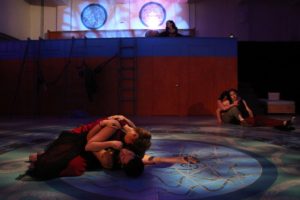
Each pairing of Odysseus and Penelope has its own dynamic charge of pathos. Bauer and Jacobs are the most unsettling to watch because their story is the one that is most unexpected. The raw and real emotions of what their situation can do to people is evocative to watch and your heart cries out in following their path of discovery along this journey. There is a unwavering tenderness and strength in the match-up between Washer and Yangilmau’s Penelope and Odysseus, especially as Washer’s Penelope is flightily excitable and flits about with true merriment and hop informing her steps. As mentioned, Malkus and Gonzalez, have a potent and steamy connection, which drives their coupling forward like wildfire burst forth from Hades. There’s something for everyone to experience, enjoy, and explore among these pairings, and in the production as a whole— outside of how Penelope and Odysseus lose each other, find each other, and cope with one another in the aftermath.
The Orphan Sea is a uniquely semi-devised work— truly a different type of theatre happening here in Baltimore. Catch it in rep with La Llorona, another fine and unique theatrical endeavor with Cohesion Theatre Company this spring.
Running Time: Approximately 2 hours with one intermission
The Orphan Sea plays in repertory with La Llorona through April 15, 2018 at Cohesion Theatre Company in the Fallout Shelter of the United Evangelical Church— 3200 Dillon Street in the Canton neighborhood of Baltimore, MD. Tickets are available at the door or in advance online.

